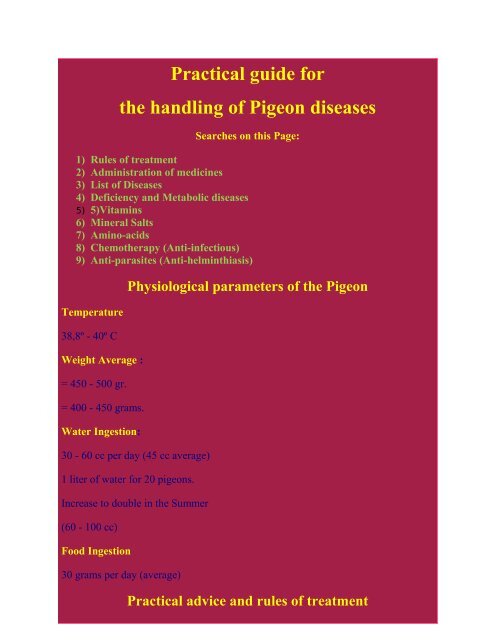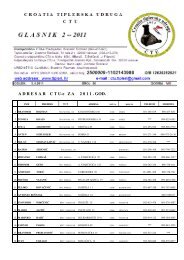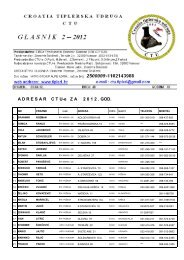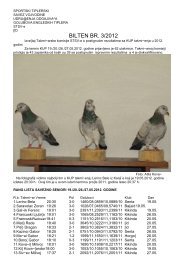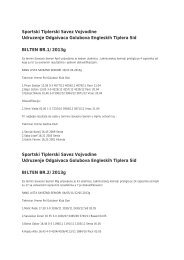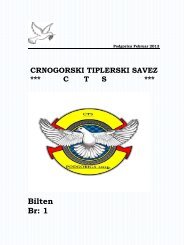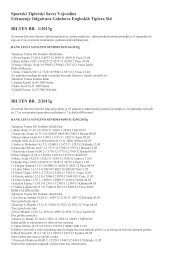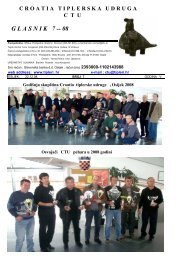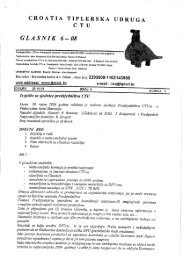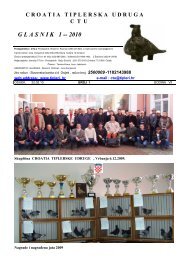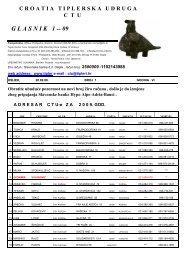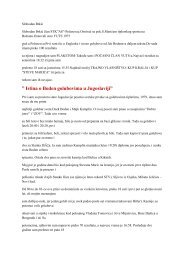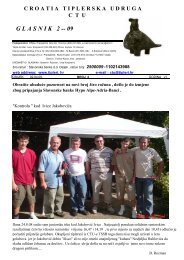Practical guide for the handling of Pigeon diseases
Practical guide for the handling of Pigeon diseases
Practical guide for the handling of Pigeon diseases
Create successful ePaper yourself
Turn your PDF publications into a flip-book with our unique Google optimized e-Paper software.
<strong>Practical</strong> <strong>guide</strong> <strong>for</strong><br />
<strong>the</strong> <strong>handling</strong> <strong>of</strong> <strong>Pigeon</strong> <strong>diseases</strong><br />
Searches on this Page:<br />
1) Rules <strong>of</strong> treatment<br />
2) Administration <strong>of</strong> medicines<br />
3) List <strong>of</strong> Diseases<br />
4) Deficiency and Metabolic <strong>diseases</strong><br />
5) 5)Vitamins<br />
6) Mineral Salts<br />
7) Amino-acids<br />
8) Chemo<strong>the</strong>rapy (Anti-infectious)<br />
9) Anti-parasites (Anti-helminthiasis)<br />
Temperature<br />
38,8º - 40º C<br />
Weight Average :<br />
= 450 - 500 gr.<br />
= 400 - 450 grams.<br />
Water Ingestion:<br />
Physiological parameters <strong>of</strong> <strong>the</strong> <strong>Pigeon</strong><br />
30 - 60 cc per day (45 cc average)<br />
1 liter <strong>of</strong> water <strong>for</strong> 20 pigeons.<br />
Increase to double in <strong>the</strong> Summer<br />
(60 - 100 cc)<br />
Food Ingestion<br />
30 grams per day (average)<br />
<strong>Practical</strong> advice and rules <strong>of</strong> treatment
Treatment:<br />
A. - Illness - Symptomatic<br />
- General<br />
B. - Preventive or Prophylactic<br />
(Hygiene, vaccines, etc.)<br />
C. - Helping<br />
(<strong>for</strong> example: antibiotics in virus <strong>diseases</strong>)<br />
Administration <strong>of</strong> medicines<br />
Injectable <strong>for</strong>m: Subcutaneous (underneath <strong>the</strong> skin <strong>of</strong> <strong>the</strong> neck)<br />
Oral <strong>for</strong>m:<br />
1. - By capsules or tablets (individual treatment)<br />
2. - In <strong>the</strong> drink water: administer <strong>the</strong> right amount <strong>of</strong> water that is consumed<br />
per day according to <strong>the</strong> time <strong>of</strong> <strong>the</strong> year (winter or summer). The vitamins in<br />
<strong>the</strong> water from a day to ano<strong>the</strong>r will be inactivated.<br />
3. - In <strong>the</strong> food: it is not recommended.<br />
4. - Topics: with a small stick and cotton (Muguet case, trichomoniasis, smallpox,<br />
etc)<br />
Doses:<br />
Insufficient dose:<br />
It doesn't produce <strong>the</strong> wished treatment and causes resistance or to be dependent.<br />
Overdose:<br />
It can cause very detrimental effects (case sulfas)<br />
Measures:
1 c<strong>of</strong>fee spoon = 1.5 - 2 grams.<br />
1 teaspoon = 3, 5 - 4 grams.<br />
1 soupspoon = 8 - 10 grams.<br />
1 soup spoonful = 15 grams.<br />
20 drops = 1 milliliter = 1 cc<br />
Important:<br />
Whenever antibiotics are administered (tetracycline, tyrosine, eritromicina, etc), it is<br />
necessary to provide vitamins, electrolytes, amino acids and reconstituyentes <strong>of</strong> <strong>the</strong><br />
intestinal flora. (Ex.: acid fil<strong>of</strong>ago, yoghurt). In <strong>the</strong> case <strong>of</strong> administering<br />
TETRACICLINAS (tetrramicina MR), suppress <strong>the</strong> GRIT during those days as <strong>the</strong><br />
calcium salts precipitate <strong>the</strong> antibiotic and <strong>the</strong>y inactivate it. Do not use interactive<br />
products simultaneously: <strong>the</strong>y can produce interference, cooperation, antagonism or<br />
it can change <strong>the</strong> effect desired.<br />
Prophylaxis or prevention<br />
Disinfection <strong>of</strong> <strong>the</strong> l<strong>of</strong>t and all <strong>the</strong> facilities: at <strong>the</strong> present time IODINE<br />
POVIDONA is <strong>the</strong> antiseptic par excellence. It has bacterial, vermicide and<br />
Fungicide action. Apply it with spray whenever we clean <strong>the</strong> l<strong>of</strong>t ( minimum<br />
Once a week).Dilution: 20 cc in 1 liter <strong>of</strong> water.<br />
SALMONELOSIS Or PARATIFOSIS<br />
PASTEURELOSIS Or COLERA<br />
CORIZA<br />
ORNITOSIS<br />
LIST OF DISEASES<br />
BACTERIAL (bacterium)<br />
INFECTIOUS
MICOPLASMOSIS<br />
VIRÓSICAS (virus)<br />
NEW CASTLE Or PARAMIXOVIRUS<br />
ADENOVIRUS<br />
HERPES VIRUS<br />
DIFTERO - SMALLPOX<br />
MICÓTICAS (fungus)<br />
ASPERGILOSIS<br />
CADIDIASIS Or MUGUET<br />
PARASITIC<br />
INTERNAL<br />
COCCIDIOSIS<br />
ASCARIDIOSIS<br />
CAPILARIOSIS<br />
TENIASIS<br />
PROTOZOARIOS<br />
PLASMODIOSIS Or MALARIA<br />
HAEMOPROTEOSIS<br />
TRICHOMONIASIS<br />
EXTERNAL<br />
LICE<br />
ACAROS
DIPTEROS (flies)<br />
CARRAÇAS (aracnideos)<br />
SALMONELOSIS Or PARATIFOSIS<br />
Disease <strong>of</strong> youngsters that causes an early death without specific symptoms. The<br />
cured adult pigeon becomes into carriers and continue eliminating salmonellas,<br />
reason why it is preferable to eliminate <strong>the</strong>m. When hatching <strong>the</strong>y can transmit <strong>the</strong><br />
disease through <strong>the</strong> pores <strong>of</strong> <strong>the</strong> rind <strong>of</strong> eggs<br />
CAUSAL AGENT: Salmonella Typhimurium<br />
TRANSMISSION:<br />
Oral: By <strong>the</strong> food or <strong>the</strong> drinking water.<br />
Aerial: By inhalation <strong>of</strong> <strong>the</strong> dust.<br />
Ovarian: Of <strong>the</strong> ovary to <strong>the</strong> egg.<br />
SYMPTOMS:<br />
4 <strong>for</strong>ms<br />
1 - Intestinal: diarrhea with thick lees surrounded by snots, elements no digested<br />
in dirty water <strong>of</strong> brown or green, and frothy color. Thickening <strong>of</strong> <strong>the</strong> sewer.<br />
Thinning.<br />
2 - Articulate: <strong>of</strong> <strong>the</strong> internal goes to <strong>the</strong> blood and from <strong>the</strong>re to <strong>the</strong> joints <strong>of</strong><br />
greater movement (elbow). Fallen wing<br />
3 - Organic: it attacks all <strong>the</strong> devices pronouncing itself with a short breath and<br />
general weakening.<br />
4 - Nervous: it attacks <strong>the</strong> brain and <strong>the</strong> spinal marrow producing:<br />
- loss <strong>of</strong> balance<br />
- paralysis
- tortícolis (similar to New Castle)<br />
DIAGNOSE: Serologic, which means <strong>the</strong> antibodies <strong>of</strong> <strong>the</strong> blood <strong>of</strong> <strong>the</strong> infected<br />
animals.<br />
TREATMENT:<br />
Antibiotics:<br />
- Tetracycline<br />
- Enr<strong>of</strong>loxacina<br />
- Furazolidona<br />
Minimum 15 days.<br />
PROPHYLAXIS:<br />
Cleaning and disinfecting (at least weekly)<br />
1 - 2 days <strong>of</strong> antibiotics every 15 days<br />
Vitamins<br />
IMPORTANT: It is a ZOONOSE (it can infect <strong>the</strong> man by a very close contact).<br />
PASTEURELOSIS Or COLERA<br />
It can attack a few pigeons, as thus also to provoke an epidemic. Normally it finishes<br />
in a fatal mode. The<br />
Overpopulation and <strong>the</strong> lack <strong>of</strong> hygiene are <strong>of</strong> <strong>the</strong> more important causing factors.<br />
CAUSAL AGENT: Pasteurella multocida<br />
SYMPTOMS:<br />
High fever 42 º - 43º C<br />
diarrhea<br />
Death between 24 - 48 hrs.
TREATMENT:<br />
Tetracycline<br />
Enr<strong>of</strong>loxacina<br />
Vitamins<br />
PROPHYLAXIS: Cleaning and disinfecting (iodine providing) CORIZA<br />
CAUSAL AGENT: Hemophilic influenza<br />
SYMPTOMS:<br />
Tears in both eyes at <strong>the</strong> same time. Swelling <strong>of</strong> <strong>the</strong> lachrymal coats (owl head).<br />
Slight nasal unloading (snot)<br />
DIAGNOSE: Bacteriological examination <strong>of</strong> nasal and ocular secretions.<br />
TREATMENT: Antibiotics - Vitamins.<br />
PROPHYLAXIS: Cleaning and disinfecting (iodine providing)<br />
MICOPLASMOSIS<br />
Micro plasma - Microorganism halfway between a bacterium and a virus. Cured<br />
pigeons acquire immunity, however <strong>the</strong>y happen to be carrying and transmitting <strong>the</strong><br />
illness to <strong>the</strong> youngsters. This disease generally is associate to <strong>the</strong> ORNITOSIS.<br />
Many pigeons are carrying and <strong>the</strong> <strong>diseases</strong> appear after <strong>the</strong> ef<strong>for</strong>t <strong>of</strong> a difficult<br />
competition.<br />
CAUSAL AGENT: Micro plasma<br />
SYMPTOMS:<br />
Nasal, watery humid secretion and becomes sticky and mucous. Inside <strong>the</strong> mouth a<br />
gray, rough scab, tongue and sticky palate. Very disagreeable breath (repulsive).<br />
Nose <strong>of</strong> dirty gray color. Very difficult breathing. Very strong noises at night. Very<br />
slow evolution. It is rare to have a generalized infection but when happens <strong>the</strong><br />
diminishing <strong>of</strong> <strong>the</strong> defenses (stress, <strong>the</strong> races, lack <strong>of</strong> hygiene, overpopulation etc.)<br />
can cause deaths.<br />
DIAGNOSE: Serologic examination <strong>of</strong> <strong>the</strong> antibodies <strong>of</strong> <strong>the</strong> attacked pigeons.
TREATMENT: Tyrosine (Tylla MR) ENROFLOXACINA. Administer it to 5 days<br />
consecutive<br />
PROPHYLAXIS:<br />
Deep disinfection. Preventive treatments can be done in <strong>the</strong> weeks frees <strong>of</strong> races and<br />
mainly after a hard one.<br />
CAUSAL AGENT: Chlamydia<br />
SYMPTOMS:<br />
Similar to influenza.<br />
ORNITOSIS<br />
Nasal and ocular secretion similar to <strong>the</strong> micoplasmosis<br />
Diarrheas----> slow thinning -> death.<br />
DIAGNOSE: Laboratory (Stamp method)<br />
TREATMENT: Clortetraciclinas + Tyrosine.<br />
PROPHYLAXIS: Deep disinfection.<br />
IMPORTANT: EYE IS A ZOONOSE.<br />
NEW CASTLE Or PARAMIXOVIRUS<br />
CAUSAL AGENT: Bird Paramixovirus type 1<br />
SYMPTOMS:<br />
1 - Digestive upheavals:<br />
Virus - vicerotropo<br />
- Liquid Excrements ----> (as water)<br />
- Intense thirst (it can increase to 4-5 times <strong>the</strong> consumption)<br />
2 - Nervous upheavals:
- virus neurotropo<br />
- Slight tremors <strong>of</strong> head.<br />
- Difficulty to peck grains (it affects <strong>the</strong> optical nerve).<br />
- Problems <strong>of</strong> balance: it falls <strong>for</strong> a side or back towards (pirouettes)<br />
- Torticolis: <strong>of</strong> 0º - 180 º<br />
- Problems in sight with discoloration <strong>of</strong> an eye.<br />
- Paralysis <strong>of</strong> a wing or <strong>the</strong> two.<br />
- Paralysis <strong>of</strong> a leg or <strong>the</strong> two.<br />
3 - Breath upheavals (Virus neumotropo)<br />
- Conjunctivitis, chorizo, death rattle. (They are not frequent)<br />
DIAGNOSE: Laboratory, by examination <strong>of</strong> <strong>the</strong> blood.<br />
TREATMENT:<br />
To eliminate sick pigeons <strong>of</strong> small value.<br />
To isolate <strong>the</strong> pigeons that we want to treat. Reduce to normality <strong>the</strong> water<br />
Consumption (50 centiliters per day).<br />
To fulfill <strong>the</strong> food trays or to give <strong>the</strong>m to eat with a sleeve or syringe.<br />
To administer toge<strong>the</strong>r:<br />
- Antibiotics (Tetracycline, enr<strong>of</strong>loxacina, etc.)<br />
- Amino acids<br />
- Vitamins<br />
- Levamisol (to stimulate <strong>the</strong> defenses).<br />
PROPHYLAXIS: Cleaning and disinfecting <strong>of</strong> <strong>the</strong> l<strong>of</strong>t.
VACCINATION:<br />
a) Dead virus: or inactivated in watery solution.<br />
Intramuscular or subcutaneous.<br />
Immunity: a year COLOMBOVAC (Holland)<br />
b) Alive virus: Cepa B1 or La Sota.<br />
In <strong>the</strong> water <strong>of</strong> drink and by nasal or ocular drop.<br />
Immunity: 2 months. On <strong>the</strong> 4th day <strong>of</strong> applied <strong>the</strong> vaccine to <strong>the</strong> alive virus it is<br />
advisable to make <strong>the</strong> following recipe:<br />
- Levamisol: 1-2 days<br />
- Vitamins, Antibiotics and Amino acids: during 4-5 days.<br />
IMPORTANT:<br />
It is an obligation <strong>of</strong> <strong>the</strong> Fancier to denounce or to communicate to his society a<br />
bud <strong>of</strong> this disease in his l<strong>of</strong>t, so that all <strong>the</strong> o<strong>the</strong>r people can take <strong>the</strong>ir own<br />
Precautions.<br />
ADENOVIRUS<br />
It is little what it’s known about this disease caused by a virus that has its preference<br />
by <strong>the</strong> devices <strong>of</strong> <strong>the</strong> lymphatic system (ganglia, bazo). That’s where its name comes<br />
from.<br />
CAUSAL AGENT:<br />
SYMPTOMS:<br />
During <strong>the</strong> breeding it is very common to observe <strong>the</strong> unequal growth <strong>of</strong> <strong>the</strong><br />
youngsters. The frequent vomits are one <strong>of</strong> <strong>the</strong> symptoms most characteristic <strong>of</strong> <strong>the</strong><br />
disease.<br />
TREATMENT: Homeopathic substances.
PROPHYLAXIS: Cleaning and disinfection <strong>of</strong> <strong>the</strong> pigeons.<br />
HERPES VIRUS<br />
Virus disease <strong>of</strong> recent appearance. There have been some cases in <strong>the</strong> Buenos<br />
Aires.<br />
DIFTERO SMALLPOX<br />
CAUSAL AGENT: Borrelia Columbia (virus)<br />
INFECT:<br />
By <strong>the</strong> water <strong>of</strong> drink, food, fecal material, dust, pricked <strong>of</strong> mosquito, wounds, etc.<br />
Youngsters are most susceptible. The adults rarely become sick.<br />
SYMPTOMS:<br />
Typical crust <strong>for</strong>mation white yellowish, difficult to give <strong>of</strong>f (blood ones), in eyes,<br />
Nose, peak, toggle <strong>of</strong> <strong>the</strong> legs, mouth, throat, around <strong>the</strong> sewer.<br />
TREATMENT:<br />
To separate <strong>the</strong> excrescences and to apply dye topics <strong>of</strong> iodine. Give antibiotic and<br />
Vitamins (mainly vitamin A) during 4-5 days.<br />
PROPHYLAXIS: Cleaning and disinfection (iodine providing)<br />
IMMUNITY: The cured pigeon acquires immunity <strong>for</strong> a lifetime.<br />
CAUSAL AGENT:<br />
A tiny parasite. Two species:<br />
Eimeria Labbeana<br />
Eimeria Columba rum<br />
SYMPTOMS:<br />
COCCIDIOSIS
Two <strong>for</strong>ms:<br />
Clinical: proper <strong>of</strong> <strong>the</strong> adult pigeon. There is no symptom but it diminishes <strong>the</strong><br />
Sport per<strong>for</strong>mance. There is certain immunity.<br />
Itself: It attacks young pigeons at <strong>the</strong> third week <strong>of</strong> age. Watery and faded faucal<br />
Material, sometimes with blood (never liquid and green). Loss <strong>of</strong> weight and<br />
Forms. Loss <strong>of</strong> color <strong>of</strong> <strong>the</strong> rainbow <strong>of</strong> <strong>the</strong> eye, changes grayish. Mucous <strong>of</strong> <strong>the</strong><br />
Mouth and <strong>the</strong> throat become pale (anemia). Opaque plumage.<br />
DIAGNOSE: Analysis <strong>of</strong> faucal material.<br />
TREATMENT:<br />
Sulfamidas "<strong>the</strong> continued use in <strong>the</strong> eye, causes damages at renal level"<br />
Emporium<br />
Cloazuril<br />
Toltazuril (Baycox Mr.)<br />
PROPHYLAXIS:<br />
Alternate <strong>the</strong> above-mentioned drugs every 30 days in a preventive <strong>for</strong>m.<br />
Possibility to use this treatment toge<strong>the</strong>r with <strong>the</strong> one against trichomonas. Once<br />
Finished <strong>the</strong> treatment, give vitamins during 3-4 days. Deep cleaning and general<br />
disinfection (do not <strong>for</strong>get that <strong>the</strong> eggs <strong>of</strong> coccidian reproduce in <strong>the</strong> accumulated<br />
faucal matter in <strong>the</strong> floor or trays being necessary three conditions: temperature,<br />
Humidity and oxygen. There<strong>for</strong>e we must prevent <strong>the</strong> humidity).<br />
ASCARIDIOSIS<br />
CAUSAL AGENT:
Ascaris Columbine.<br />
The cycle where <strong>the</strong> egg <strong>of</strong> <strong>the</strong> parasite is eliminated by <strong>the</strong> faucal matter, goes to<br />
<strong>the</strong> ground, is developed <strong>the</strong> larva and again it is ingested, matured and again<br />
eliminated it is <strong>of</strong> 20 days <strong>for</strong> that reason it recommends <strong>the</strong> preventive treatment<br />
every 21 days)<br />
SYMPTOMS:<br />
Few roundworms cause little damage, but if <strong>the</strong> number increases too much it<br />
Produces a reduction <strong>of</strong> <strong>the</strong> sports per<strong>for</strong>mance and inflict many casualties.<br />
- Anorexia (loss <strong>of</strong> appetite)<br />
- Loss <strong>of</strong> weight.<br />
- Weakness<br />
- Little consistent faucal material.<br />
- Intense thirst.<br />
- Anemia<br />
- Opaque and made bristle plumage.<br />
- We can see <strong>the</strong> parasites in <strong>the</strong> excrements and sometimes in vomits. The<br />
Damages caused by <strong>the</strong>se parasites are imputed to 3 reasons.<br />
1 - The wounds that cause in intestinal wall<br />
2 - Because <strong>the</strong>y absorb many elements nutritious.<br />
3 - Because <strong>the</strong>y excrete toxic substances.<br />
DIAGNOSE: Analysis <strong>of</strong> fecal material<br />
TREATMENT:
There are different drugs:<br />
- Levamisol -RIPERCOL MR<br />
- Piperazina<br />
- Ivermectina (Ivomec Mr)<br />
PROPHYLAXIS:<br />
Alternate <strong>the</strong> treatment with <strong>the</strong> above-mentioned drugs every 30 days. In this way<br />
We diminished <strong>the</strong> possibility <strong>of</strong> dependence to <strong>the</strong> drug. Do not <strong>for</strong>get that <strong>the</strong><br />
LEVAMISOL is an excellent inmunomodulator as well (stimulating <strong>of</strong> <strong>the</strong><br />
Defenses) <strong>the</strong>re<strong>for</strong>e its use is essential whenever we vaccinate against New Castle.<br />
The old animals develop certain immunity.<br />
Cleaning - hygiene. Disinfection<br />
CAPILARIOSIS<br />
CAUSAL AGENT:<br />
Capillary obstinate<br />
Is considered that this parasite is present in 50 % <strong>of</strong> <strong>the</strong> pigeons, but particularly is<br />
More sensible in <strong>the</strong> young animals.<br />
SYMPTOMS:<br />
A slight infection practically does not produce symptoms, only diminution in <strong>the</strong><br />
Sport per<strong>for</strong>mance. But if <strong>the</strong> infection is serious, youngsters can die one week after<br />
Starting <strong>the</strong> disease.<br />
DIARREA ----> THINNING -----> DEATH<br />
DIAGNOSE: Idem ascaridiosis.
TREATMENT: Idem ascaridiosis. (NO PIPERAZINA)<br />
PROPHYLAXIS: Idem ascaridiosis<br />
TENIASIS<br />
Of this infection I only want to reveal that it is important as prophylaxis, to fight all<br />
<strong>the</strong> intermediate hosts (larvae <strong>of</strong> mosquitoes, cockroaches, weevils, slimy, snails,<br />
etc) <strong>the</strong> tapeworms or <strong>the</strong> ring <strong>of</strong> tapeworms are sometimes visible in <strong>the</strong> sewer <strong>of</strong><br />
<strong>the</strong> pigeon. It is common that <strong>the</strong>y appear in pigeons that been have lost <strong>for</strong> a certain<br />
period. The treatment is individual - Niclosamida.<br />
CAUSAL AGENT:<br />
Trichomona Columbine (a protozoário)<br />
TRICHOMONIASIS<br />
We considered that 80% <strong>of</strong> <strong>the</strong> old pigeons are carrying, being able to happen<br />
Inadvertent. It is used to say that <strong>the</strong> olders live in balance with trichomonas in<br />
Ominous consequences. In <strong>the</strong> youngsters is fatal.<br />
SYMPTOMS:<br />
- Apathy<br />
- Spiny plumage.<br />
- Viscous diarrhea ---> thinning.<br />
- Intense thirst<br />
- Anorexia (lack <strong>of</strong> appetite)<br />
- Disnea (difficult breading: penguin position)<br />
- White and yellow spots in <strong>the</strong> mouth and throat.<br />
DIAGNOSE: Microscopic examination <strong>of</strong> isopods <strong>of</strong> crop and esophagus.<br />
TREATMENT:
Dimetridazol (EMTRIL MR)<br />
1 gr. by liter <strong>of</strong> water during 7 days.<br />
METRONIDAZOL<br />
RONIDAZOL<br />
PROPHYLAXIS: Hygiene and general disinfection.<br />
IMUNIDADE:<br />
A small amount <strong>of</strong> trichomonas in pigeons with good health causes its own<br />
Antibodies.<br />
PLASMODIOSIS Or MALARIA<br />
Disease <strong>of</strong> <strong>the</strong> costal zones (bordering to <strong>the</strong> rivers)<br />
CAUSAL AGENT: A esporozoario <strong>of</strong> kind PLASMODIUM<br />
EPIZOOTIOLOGIA:<br />
There are three factors that condition <strong>the</strong> maintenance and development <strong>of</strong> <strong>the</strong><br />
malaria:<br />
- Carrying or sick Birds.<br />
- transmitting Mosquitoes (culex, heads, anopheles).<br />
- <strong>the</strong> temperature, rains and <strong>the</strong> flora <strong>of</strong> region (essential elements <strong>for</strong> <strong>the</strong><br />
reproduction <strong>of</strong> <strong>the</strong> mosquito)<br />
SYMPTOMS:<br />
- Apathy<br />
- Fever it raises and low)<br />
- Anemia (<strong>of</strong> <strong>the</strong>re <strong>the</strong> eye and <strong>the</strong> white mucous)
- General weakness<br />
- Death in <strong>the</strong> youngsters.<br />
After this acute phase, where <strong>the</strong> symptoms are evident, <strong>the</strong> plasmodiosis enters a<br />
period <strong>of</strong> diminution <strong>of</strong> <strong>the</strong>ir clinical manifestations and parasitemia to<br />
end globular arriving at a stage <strong>of</strong> normality between <strong>the</strong> 30 - 40 days <strong>of</strong> begun <strong>the</strong><br />
Symptoms.<br />
DIAGNOSE: Examination <strong>of</strong> <strong>the</strong> blood (method <strong>of</strong> Giemsa).<br />
TREATMENT:<br />
Plasmodicidas used in <strong>the</strong> human malaria:<br />
Quitina<br />
Atebrina<br />
Plasmoquina<br />
Cloronquina<br />
Pludrina<br />
For ex.: <strong>the</strong> cloroquina or ARALEN MR (2 mg by kg <strong>of</strong> weight that is 1 mg. by<br />
<strong>Pigeon</strong>. 3 doses day by average.<br />
PROPHYLAXIS:<br />
Avoid <strong>the</strong> mosquito:<br />
-Metallic net<br />
-Fuyi Vape<br />
-Kaotrina<br />
IMUNIDADE The cured animals develop certain degree <strong>of</strong> immunity
HAEMOPROTEOSIS<br />
CAUSAL AGENT:<br />
Haemoproteus Columbine.<br />
It has a definitive host, a fly haemotografe (he is fed on blood), pseudolynchia<br />
Canariensis.<br />
The intermediary host is <strong>the</strong> pigeon. It is necessary that <strong>the</strong> infested fly<br />
Resentment <strong>the</strong> pigeon to developed this disease.<br />
SYMPTOMS:<br />
Seen only in <strong>the</strong> summer months. The symptoms are very similar to those <strong>of</strong> <strong>the</strong><br />
Plasmodiosis, so it’s possible a confusion (due to time and symptoms).<br />
The flies that suck infected blood are able to transmit <strong>the</strong> haemoproteosis 15 days<br />
late and between 25 to 30 days later begin <strong>the</strong> symptoms:<br />
- Recurrent fever (it raises and low) 43 º C<br />
- Diarrhea: White lees or yellowish, liquid and persistent.<br />
- Disnea: increase <strong>of</strong> <strong>the</strong> respiratory frequency.<br />
- Gradual Anemia<br />
- Caquexia: Weakness when <strong>the</strong> disease becomes chronicle.<br />
DIAGNOSE: Examination <strong>of</strong> <strong>the</strong> blood (method <strong>of</strong> Giemsa)<br />
TREATMENT: NONE<br />
PROPHYLAXIS: Fight <strong>the</strong> fly: Kaotrina<br />
CANDIDIASIS Or MUGUET<br />
Some authors describe this disease toge<strong>the</strong>r with <strong>the</strong> trichomoniasis and o<strong>the</strong>rs speak<br />
<strong>of</strong> an associate mitotic
Disease due to Vitamin A deficiency.<br />
CAUSAL AGENT: a fungus: CANDIA ALBICANS<br />
SYMPTOMS:<br />
White or yellowish spots (easy to give <strong>of</strong>f) in all <strong>the</strong> mucosa <strong>of</strong> <strong>the</strong> mouth and <strong>the</strong><br />
Throat.<br />
TREATMENT:<br />
Topic applications with iodine providing to 10% or weak iodine dye (diluted with<br />
Glycerin) in <strong>the</strong> spots. Administer Vitamin A.<br />
PROPHYLAXIS:<br />
- AVOID THE PROLONGED STORAGE OF FOODS<br />
- GIVE SUNSHINE TO THE GRAINS BEFORE FEED<br />
- VITAMIN A<br />
- LOFT DISINFECTION<br />
ASPERGILOSIS<br />
CAUSAL AGENT:<br />
A fungus, Aspergillum fumigates. It reproduces quickly in <strong>the</strong> straw <strong>of</strong> <strong>the</strong> nests, or<br />
In <strong>the</strong> humid food.<br />
SYMPTOMS:<br />
It is an infection <strong>of</strong> <strong>the</strong> group <strong>of</strong> <strong>the</strong> respiratory <strong>diseases</strong>. It appears under two <strong>for</strong>ms:<br />
PULMONARY FORM:<br />
Respiratory difficulty (disnea)<br />
Greenish excrescences on <strong>the</strong> tongue and palate.
DERMATOLOGIC FORM:<br />
Bare skin and with fractures <strong>of</strong> pens<br />
TREATMENT: NONE. Does not exists one that is effective<br />
PROPHYLAXIS:<br />
Dry and well aired l<strong>of</strong>t.<br />
Avoid <strong>the</strong> humidity in <strong>the</strong> food.<br />
Disinfection (iodo providing)<br />
LICE, ACARUSES, DIPTEROS (flies), CARRAÇAS.<br />
With respect to <strong>the</strong> subject I am not going to extend, I will only say that lice, mites,<br />
flies and garrapatas (a kind <strong>of</strong> aracnideos) exists in <strong>the</strong> pigeons and that cause<br />
damages in <strong>the</strong> plumage, sometimes quite seriously. The best way to fight <strong>the</strong>m is<br />
with an aspersion bath but never with an immersion one. It is also necessary to<br />
consider to not use products derived from <strong>the</strong> piretrins (by: kaotrina) because is toxic<br />
<strong>for</strong> <strong>the</strong> birds, and although poisoning symptoms are not pronounced can cause low<br />
per<strong>for</strong>mance in <strong>the</strong> races.<br />
CARBARIL 5 % (in powder)<br />
NEVER USE GAMEXANE<br />
DEFICIENCY AND METABOLIC DISEASES<br />
Within this group <strong>of</strong> infections I have included <strong>the</strong> ones which produced by<br />
deficiencies<br />
(<strong>of</strong> vitamins, minerals salts or amino acids) and tumors.<br />
VITAMINS AND THEIR DEFICIENCIES<br />
It is practically impossible to produce a hipervitaminosis or<br />
Overdose <strong>of</strong> vitamins. All <strong>the</strong> ingested excess, <strong>the</strong> animal <strong>the</strong><br />
Metabolizes and eliminates it.
DEFINITION:<br />
The existing vitamins are organic substances in foods, incapable<br />
to be syn<strong>the</strong>sized by <strong>the</strong> organism in adequate quantities being<br />
used in small doses, <strong>for</strong> <strong>the</strong> normal functioning and maintenance<br />
Of <strong>the</strong> organism and health.<br />
According to this definition, vitamins must be supplied<br />
Periodically in order to prevent upheavals.<br />
VITAMINS:<br />
(necessities per day and pigeon)<br />
VITAMIN A: 200 UI<br />
VITAMIN D3: 45 UI<br />
VITAMIN E: 1 mg<br />
VITAMIN C: 0.7 mg<br />
VITAMIN B1: 0.1 mg<br />
VITAMIN B2: 0.12 mg<br />
VITAMIN B6: 0.12 mg<br />
NICOTINAMIDE<br />
VITAMIN B12 0.24 mg<br />
BIOTIN: 0.002<br />
mg<br />
PANTOTECNIC AC.: 0.36 mg<br />
FOLIC ACID: 0.014
mg<br />
VITAMIN A:<br />
Action:<br />
Indispensable in <strong>the</strong> <strong>for</strong>mation <strong>of</strong> <strong>the</strong> sanguineous capillaries. Form leaves from<br />
pigments <strong>of</strong> <strong>the</strong> retina (eye). Acts in <strong>the</strong> <strong>for</strong>mation <strong>of</strong> all <strong>the</strong> epi<strong>the</strong>lial coatings. It is<br />
used helping in infectious and ant parasitic <strong>diseases</strong>. Is also used as anti-stress<br />
substance and following <strong>the</strong> vaccinations.<br />
Deficiency:<br />
Sometimes it leads to <strong>the</strong> destruction <strong>of</strong> <strong>the</strong> eye (it is resembled to crisis). Viscous<br />
exudates in <strong>the</strong> nasal graves. Patognomónicas are considered <strong>the</strong> nodules or white<br />
pustules as large as a pin head that are seen in post-mouth, pharynx, origin <strong>of</strong> <strong>the</strong><br />
esophagus and stomach.<br />
VITAMIN D<br />
The organism animal syn<strong>the</strong>sizes it from <strong>the</strong> ultra-violet rays, so it’s very important<br />
<strong>of</strong> <strong>the</strong> sun in <strong>the</strong> l<strong>of</strong>t.<br />
Action:<br />
Its fundamental action is to promote <strong>the</strong> absorption and fixation <strong>of</strong> calcium and<br />
phosphorus in <strong>the</strong> skeleton.<br />
Deficiency:<br />
De<strong>for</strong>mation <strong>of</strong> <strong>the</strong> breastbone.<br />
Fragile bones.<br />
Eggs with thin and s<strong>of</strong>t rind.<br />
Fragile peak and s<strong>of</strong>t nails.<br />
Delay <strong>of</strong> <strong>the</strong> growth.<br />
Problems in <strong>the</strong> plumage.<br />
A prolonged deficiency leads to <strong>the</strong> " raquitismo " (Rachiotis = to meager)
VITAMIN E<br />
Action:<br />
It acts in <strong>the</strong> maintenance <strong>of</strong> <strong>the</strong> reproductive function <strong>of</strong> <strong>the</strong> birds. It increases <strong>the</strong><br />
fertility <strong>of</strong> eggs.<br />
Deficiency:<br />
It can produce:<br />
Encefalomacia: motor upheavals and ventral flexion <strong>of</strong> <strong>the</strong> head.<br />
White muscular dystrophy, striate throughout muscular fibers <strong>of</strong> pectoral muscles.<br />
Action:<br />
VITAMIN K<br />
It takes part in <strong>the</strong> normal process <strong>of</strong> <strong>the</strong> coagulation <strong>of</strong> <strong>the</strong> blood. It’s used helping<br />
in <strong>the</strong> treatments <strong>of</strong> <strong>diseases</strong> that produce anemia (coccidiosis, etc.)<br />
Deficiency: causes hemorrhages----> Anemia<br />
VITAMIN C:<br />
It is practically <strong>the</strong> only vitamin that <strong>the</strong> organism <strong>of</strong> <strong>the</strong> birds can syn<strong>the</strong>size in<br />
sufficient amounts.<br />
Action:<br />
Its main action is to <strong>for</strong>m and to maintain <strong>the</strong> intercellular material. Also it acts in<br />
<strong>the</strong> spare part <strong>of</strong><br />
Calcium and phosphorus.<br />
It’s used like anti-stress and helping in parasitic infectious <strong>diseases</strong>.<br />
Action:<br />
VITAMIN B1 Or TIAMINE :><br />
It is <strong>the</strong> anti-neurotic vitamin (anti-nervous)
It’s also necessary in <strong>the</strong> metabolism <strong>of</strong> carbon hydrates.<br />
Deficiency:<br />
It can produce:<br />
- Nervous symptom, paralysis <strong>of</strong> <strong>the</strong> legs and <strong>the</strong> muscles.<br />
- Atrophy <strong>of</strong> <strong>the</strong> genital devices<br />
VITAMIN B2 RIVOFLAVINE:<br />
Deficiency:<br />
diarrhea<br />
Delay in <strong>the</strong> growth<br />
Paralysis <strong>of</strong> <strong>the</strong> legs, supports <strong>the</strong> tarsus and doubles <strong>the</strong> fingers inwards<br />
VITAMIN B6 Or PIRIDOXINE:<br />
Deficiency:<br />
Anorexia (loss <strong>of</strong> appetite)<br />
Delay in <strong>the</strong> growth<br />
Nervous symptoms: spasmodic convulsions, jumps.<br />
NICOTINIC ACID Or NICOTINAMIDE:<br />
Action: Essential in <strong>the</strong> metabolism <strong>of</strong> carbon hydrates (sugars)<br />
Deficiency:<br />
It can produce:<br />
Inflammations in mouth, pharynx, and esophagus.<br />
Inflammation <strong>of</strong> <strong>the</strong> knee and to hoop <strong>the</strong> legs.<br />
BIOTINE:<br />
Deficiency: It can produce dermatitis in <strong>the</strong> legs (rough legs, with crack and
necrosis)<br />
FOLIC ACID:<br />
Deficiency:<br />
It can produce:<br />
- Anemia.<br />
- Delay in <strong>the</strong> growth<br />
- Problems in <strong>the</strong> plumage,<br />
- PEROSIS: It is a joint deficiency with <strong>the</strong> lack <strong>of</strong> manganese (Mn).<br />
Produces a landslide <strong>of</strong> <strong>the</strong> sinew <strong>of</strong> <strong>the</strong> gastronomies outside <strong>the</strong> bony pulley <strong>of</strong> <strong>the</strong><br />
tarsi us<br />
Joint <strong>the</strong>re<strong>for</strong>e <strong>the</strong> bones suffers a torsion outwards. (most <strong>of</strong> <strong>the</strong> times a single leg)<br />
Deficiency:<br />
PANTOTENIC ACID:<br />
The symptoms are very difficult to separate <strong>of</strong> <strong>the</strong> symptoms caused by <strong>the</strong><br />
deficiency <strong>of</strong> Biotin.<br />
- Dermatitis<br />
- Breakage <strong>of</strong> <strong>the</strong> fea<strong>the</strong>rs<br />
- Perosis<br />
- Delay in <strong>the</strong> growth<br />
Action:<br />
VITAMIN B12 Or CIANOCOBALAMINE:<br />
It is <strong>the</strong> so called anti-anemic vitamin. Along with Copper and <strong>the</strong> Cobalt, are<br />
indispensable in<br />
<strong>the</strong> <strong>for</strong>mation <strong>of</strong> <strong>the</strong> elements <strong>of</strong> <strong>the</strong> blood (eritropoyesis)
Deficiency:<br />
Delay in <strong>the</strong> growth<br />
Anemia<br />
Upheavals in <strong>the</strong> molting<br />
Low in <strong>the</strong> fertility <strong>of</strong> eggs. It is important to say that all <strong>the</strong> vitamins <strong>of</strong> group B are<br />
less stable<br />
than <strong>the</strong> o<strong>the</strong>rs (<strong>the</strong>y oxidize quickly) <strong>for</strong> that reason must be used in amounts that<br />
are daily<br />
Consumed and not to leave <strong>the</strong>m in <strong>the</strong> water through until <strong>the</strong> o<strong>the</strong>r day.<br />
It is also important to know that <strong>the</strong> vitamins <strong>of</strong> group B, act to each o<strong>the</strong>r<br />
interrelated, <strong>the</strong>re<strong>for</strong>e<br />
The deficiency <strong>of</strong> one <strong>of</strong> <strong>the</strong>m means that we must provide <strong>the</strong> called “B Complex ".<br />
MINERAL SALTS<br />
DEFINITION:<br />
Indispensable substances <strong>for</strong> many processes <strong>of</strong> <strong>the</strong> animal organism. In <strong>the</strong> nature<br />
<strong>the</strong>y are under different salts <strong>for</strong>m. It is important to say that when we provide<br />
mineral complexes to <strong>the</strong> birds <strong>the</strong>se regulate <strong>the</strong>ir ingestion according to <strong>the</strong>ir<br />
necessities. Next some <strong>of</strong> <strong>the</strong> most important minerals and its main action within <strong>the</strong><br />
organism <strong>of</strong> <strong>the</strong> birds:<br />
SODIUM (Na)<br />
It acts in <strong>the</strong> absorption <strong>of</strong> <strong>the</strong> water and its later elimination (dieresis)<br />
CALCIUM (Ca) and PHOSFORO (P)<br />
Are fundamental along with vitamin D in <strong>the</strong> <strong>for</strong>mation <strong>of</strong> <strong>the</strong> bones<br />
POTASSIUM (K)<br />
Acts in <strong>the</strong> operation <strong>of</strong> <strong>the</strong> cardiac muscle (cardiac tone)
Also acts on <strong>the</strong> dieresis.<br />
MAGNESIUM (Mg) It is related intimately with Ca and P.<br />
IODINE (I) Is fundamental <strong>for</strong> <strong>the</strong> normal operation <strong>of</strong> <strong>the</strong> gland thyroid.<br />
MANGANESE (MN)<br />
Necessary <strong>for</strong> <strong>the</strong> growth and <strong>the</strong> reproduction. Its deficiency as we<br />
saw be<strong>for</strong>e causes PEROSIS<br />
COPPER (Cu) and COBALT (Co)<br />
Are fundamental toge<strong>the</strong>r with <strong>the</strong> B12 vitamin, in <strong>the</strong> eritorpoyesis<br />
(this means <strong>for</strong>mation <strong>of</strong> <strong>the</strong> elements <strong>of</strong> <strong>the</strong> blood: globules)<br />
IRON (Fe) Essential component and <strong>the</strong> hemoglobin <strong>of</strong> <strong>the</strong> blood.<br />
DEFINITION:<br />
AMINO ACIDS<br />
They are substances that <strong>the</strong> animal organism syn<strong>the</strong>sizes from ingested nitrogen,<br />
being this base <strong>of</strong> <strong>the</strong> <strong>for</strong>mation <strong>of</strong> proteins. (A protein is a chain <strong>of</strong> amino<br />
acids).The essential amino acids are those that <strong>the</strong> organism does not syn<strong>the</strong>size in<br />
suitable amounts to maintain <strong>the</strong> growth or <strong>the</strong> normal nutrition, so <strong>the</strong>y must appear<br />
in <strong>the</strong> diet that we give our birds.<br />
Next I detail to <strong>the</strong> 10 essential amino acids and <strong>the</strong>ir requirements by pigeon and<br />
day:(necessities per day and pigeon)<br />
METIONINA 0.09 grams<br />
LESINA 0.18 grams<br />
VALINA 0.06 grams<br />
LEUCINA 0.09 grams<br />
ISOLEUCINA<br />
0.055
grams<br />
FENILALAGNINA 0.09 grams<br />
TRIPTOFANO 0.02 grams<br />
ARGININA<br />
HISTIDINA<br />
TREONINA<br />
CHEMOTHERAPY ANTI-INFECTIOUS<br />
CLASS NAME ACTION DOSE TOXICITY<br />
SINTETICS<br />
SULFAMETOXAZOL Bactereostátic<br />
P.O.: 100mg/pigeon/<br />
day<br />
Can <strong>for</strong>m renales<br />
crystals<br />
TRIMETROPIN Bacteriostátic<br />
P.O.: 10-20 mg./pigeon<br />
200 mg/liter <strong>of</strong> water<br />
Use combined with<br />
sulfametoxazol<br />
FURALTADONA<br />
FURAZOLIDONA<br />
Bacteriostátic
Bacteriostátic<br />
P.O.: 7.5 mg/pigeon/day<br />
Ample active specter against micoplasma<br />
ENROFLOXACINA<br />
Baytril MR<br />
Bactericidal P.O.: 5-10 mg/pigeon<br />
200 mg/liter <strong>of</strong> water<br />
Ample active specter against microplasma<br />
BIO-SINTETICS Or ANTIBIOTICS<br />
AMPICILINA<br />
AMOXICICLINA<br />
Bactericidal Not recommend its use in birds<br />
TILOSINA<br />
Tylan Mr<br />
Bacteriostátic P.O.:12-25 mg/pigeon<br />
Indicated in micro plasmas is<br />
NEOMICINA Bactericidal P.O.:5-25 mg/pigeon<br />
Used in infectious diarrheas<br />
ESTREPTOMICINA Bactericide P.O.:50-100 mg/pigeon Previous item<br />
CLORANFENICOL Bacteriostátic<br />
P.O.:50 mg/pigeon/2 per day<br />
Prolonged administration causes fatal anemia.
CLORTETRACICLINA<br />
Bacteriostátic ample specter<br />
P.O.:15-25 mg/pigeon<br />
day/1-1.5 g/liter water<br />
Retire <strong>the</strong> grit during its administration<br />
ANTIMICOTICS<br />
NISTATINA<br />
Nstatin MR Candidacies<br />
P.O.:100.000u/liter water during 3 weeks<br />
KETACONAZOL Candidacies<br />
P.O.:12-15 mg/pigeon<br />
2 x day/15 days<br />
ANTI-PARASITES (ANTI-HELMINTHIASIS)<br />
(helminthiasis - to have worms in <strong>the</strong> intestines)<br />
CLASS NAME ACTION DOSE TOXICITY AGAINST NEMATODES<br />
PIPERAZINA Ascaris adults P.O.:0.5 g/pigeon/2days<br />
LEVAMISOL<br />
RIPECOL mr<br />
Ascaricida<br />
Capilaricida<br />
P.O.:10-20 mg/pigeon, 2 days~400 mg/liter water, repeat after 15 days<br />
Can produce temporary vomits.
ROUND WORMS AGAINST TAENIAS<br />
IVERMECTINA<br />
Ivomec MR Parasites<br />
internal and external<br />
P.O.: 0.1 mg/pigeon<br />
repeat after10 days<br />
MEBENDAZOL<br />
Ascaris, capillaries and Taenias<br />
P.O.:5-7 mg/pigeon/2 days<br />
Can diminish <strong>the</strong> fertility and affect plumage in <strong>the</strong> molt<br />
ALBENDAZOL<br />
Vermix A MR<br />
Ascaris, capillaries and Taenias<br />
Previous item<br />
NICLOSAMIDA Taenias P.O.:100 mg/pigeon<br />
TRICHOMONICIDAS<br />
METRONIDAZOL Trichomonas<br />
P.O.:20-25 mg/pigeon<br />
5 days 1gr/liter <strong>of</strong> water<br />
DIMETRIDAZOL<br />
EMtril MR Trichomonas<br />
P.O.:525mg/pigeon
5 days/0.5 grams/liter<br />
An overdose is very toxic<br />
RONIDAZOL<br />
Trichonazol MR Trichomonas<br />
P.O.:2 mg/pigeon<br />
5 days/ in water 2gr/liter<br />
COCCIDICIDAS<br />
SULFAQUINOXALINA Coccidian<br />
P.O.: 50mg/pigeon<br />
0.25 g/liter water. Give 3 days rest 3 and repeat 2days more<br />
Produces calculations at renal level<br />
SULFAMERAZINA Coccidian P.O.:1.5 g/liter <strong>of</strong> water Previous item<br />
SULFADIMETOXINA Coccidian P.O.:0.5 g/liter <strong>of</strong> water Previous item<br />
CLAZURIL Coccidian<br />
P.O.: 2.5 mg/pigeon 1 day<br />
Low or null toxicity<br />
TOLTRAZURIL<br />
Baycox MR<br />
Coccidian<br />
P.O.:7-15 mg/pigeon 2 days<br />
Previous item<br />
AMPROLIUM Coccidian P.O.: 20 mg/pigeon<br />
Due to <strong>the</strong> use <strong>of</strong> several technical words, mainly active ingredients or
substances it is possible to have errors in my translation to English.<br />
Please do not hesitate to correct my English spelling or grammar.<br />
E-mail me <strong>for</strong> questions or suggestions!<br />
Special thanks to Jesús L. Rovira –<br />
Copyrights ® reserved to C.Fonseca (2000).<br />
Last update <strong>of</strong> original text: October 06, 2002<br />
REMARK: Edited and updated by David Strossmayer on January 20 th ,<br />
2013<br />
(ORIGINAL SOURCE @) http://pwp.netcabo.pt/cm.fonseca/pombos/<strong>diseases</strong>.htm (19 <strong>of</strong><br />
19)2/10/2005 3:15:51 AM


